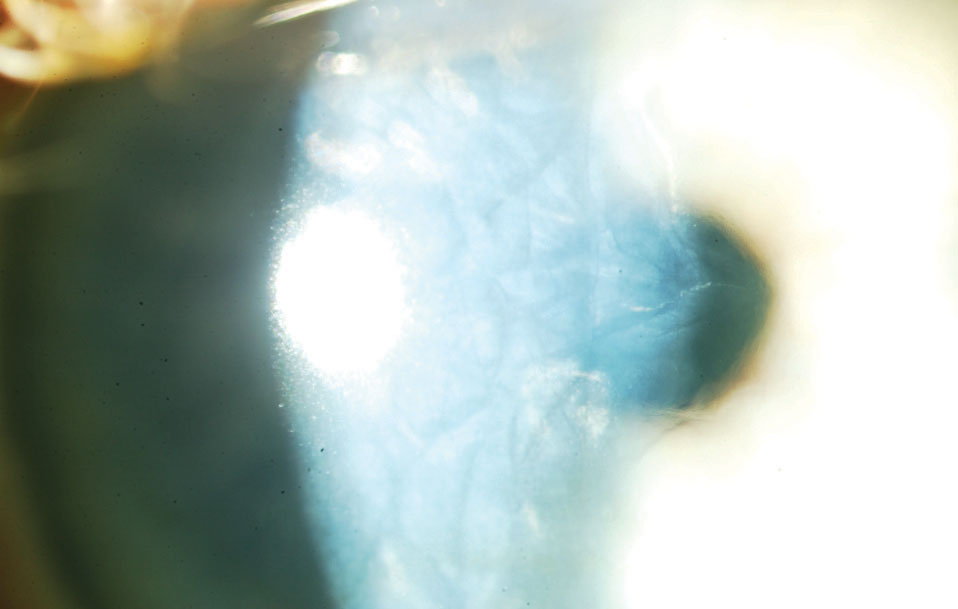 |
|
Among Medicare beneficiaries, racial and geographic factors seem to play a role in which patients receive keratoplasties. Photo: Paul M. Karpecki, OD. Click image to enlarge. |
The Medicare administrative claims database offers a way to assess sociodemographic and medical factors associated with receipt of treatment on a national level. Doing so may help recognize patients with higher risk for needing keratoplasty or lower likelihood of obtaining keratoplasty. A recent study determined that that receipt of keratoplasty in patients with Fuchs’ endothelial corneal dystrophy was associated with beneficiary sex, race and ethnicity and geographic location in the United States.
Of 719,066 beneficiaries from 2011 to 2019 identified in the Medicare fee-for-service administrative claims database with Fuchs’ who were 65 years old or older, 4.4% received a first-time endothelial keratoplasty (EK), and 0.3% received a first-time penetrating keratoplasty (PK). The mean age of those who received either surgery was 77.0, 62.7% were female and 90.8% Caucasian (non-Hispanic).
The multivariable analysis determined that female sex decreased likelihood of both PK and EK (adjusted odds ratio for EK, [aOR] 0.83; for PK, 0.84), while Western residence (aOR: 1.33; 1.25) and history of complex/other anterior segment surgery (aOR: 1.62; 5.52) increased likelihood of both procedures.
Compared with Caucasian (non-Hispanic), likelihood of EK was decreased for Black (aOR: 0.76), Asian/Pacific Islander (aOR: 0.54), and Hispanic/Latino (aOR: 0.62) race and ethnicity, while for the same groups, likelihood of PK was increased (aOR for Black 1.32; Asian/Pacific Islander 1.46; Hispanic/Latino 1.62).
Following cataract or complex/other anterior segment surgery, rates of EK were 1.3% and 3.3% at one year, and 2.3% and 5.6% at eight years, respectively.
The researchers hypothesized that social factors may play a role in this observation of beneficiary race and ethnicity, as bias could lead to different rates of initially offering surgery among different ethnic patient groups.
“Population-wide differences in treatment seeking behavior could lead to non-Caucasian beneficiaries seeking care later, leading to lower rates of EK and higher rates of PK due to more advanced disease,” the team noted in their paper.
Nevertheless, the study determined that this combination of decreased likelihood of EK with increased likelihood of PK suggests that other social determinants of health may be at play and requires further exploration to help identify solutions to improve health equity.
Patients residing in the West and Midwest were associated with higher likelihood of undergoing transplantation, but Midwest residence was significant only in EK, not PK. The study proposed that future studies should investigate provider annual surgical volume related to likelihood of performing keratoplasty for Fuchs’ of comparable severity. It also suggested that the impact of Fuchs’ on activities of daily living, such as the need to drive and/or availability of public transportation, may be a contributing factor in these geographic differences.
The researchers concluded that their data “may be useful when counseling patients about rates of EK following cataract or complex surgeries, may serve as a point of comparison as alternative treatments for Fuchs’ such as Descemet’s stripping only and cell injection therapy are investigated and may inform future efforts to increase diversity in clinical trials’ recruitment for Fuchs’.”
Heckenlaible NJ, Dun C, Prescott C, et al. Predictors of receiving keratoplasty for Fuchs’ endothelial corneal dystrophy among Medicare beneficiaries. Ophthalmology. August 3, 2022. [Epub ahead of print]. |


